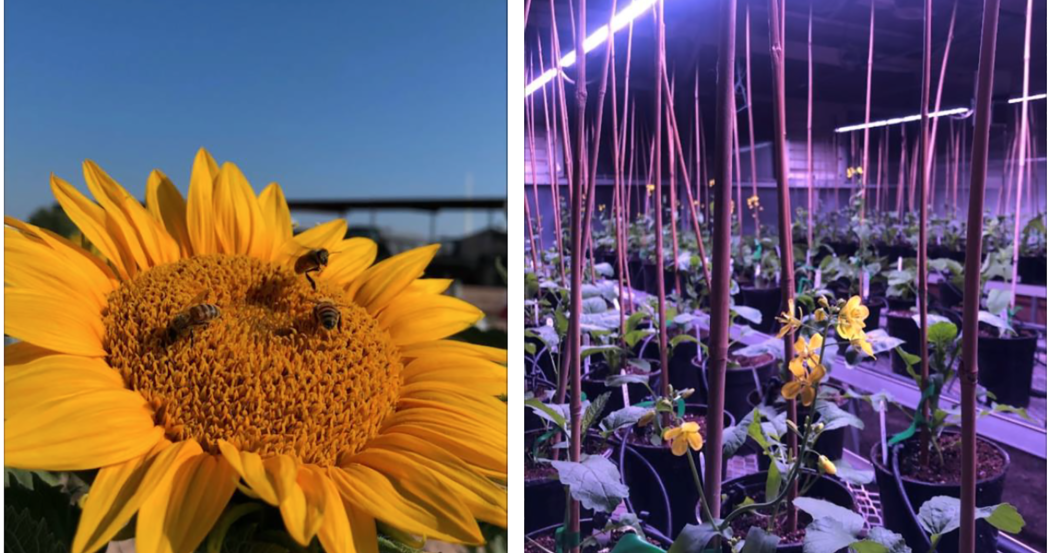By: Gloria Hoffman
The Carl Hayden Bee Research Center (CHBRC) in Tucson, Arizona is the nutrition laboratory of the USDA-ARS bee research program. The Laboratory studies nutrition in a broad sense and conducts research on defining colony nutritional needs throughout the year, acquisition of nutrients from pollen, environmental and landscape factors that can influence nutrients in pollen, and worker-worker and worker-queen interactions. The role that microbes play in nutrient metabolism and defense against invading pathogens also is investigated. The impact of nutrition on the population dynamics of colonies is another research area, as colony growth in the Spring affects its size in the Summer and Fall and the chances of surviving the Winter. Recently, we have added the effects of climate change on colony growth and survival as weather conditions can affect the availability of flowering plants, nutrient composition of pollen, overwintering survival and colony growth in the Spring.
Research at the CHBRC is led by five scientists with specialized areas of expertise that create an integrated and comprehensive program focused on honey bee nutrition. The areas are honey bee physiology (Dr. Vanessa Corby-Harris), chemical ecology (Dr. Mark Carroll), population dynamics and behavior (Drs. Gloria DeGrandi-Hoffman and William Meikle) and microbial ecology (Dr. Kirk Anderson). The following is an overview of each program highlighting how they interact to achieve the goal of providing a comprehensive understanding of nutrition that can optimize colony health and reduce colony loss. To obtain more information and read about our latest findings, go to: https://www.ars.usda.gov/pacific-west-area/tucson-az/carl-hayden-bee-research-center/
Dr. Vanessa Corby-Harris (VC-H)
The Corby-Harris laboratory studies honey bee nutrition, with the goal of improving honey bees’ access to high-quality natural forage and supplemental diets. The lab’s first area of focus is to measure how bees use the nutrients in pollen and how the patterns change with seasons. Combined with information about changes in the colony’s adult and brood population size during the annual colony cycle, these studies will determine what nutrients colonies need throughout the year. For example, in periods of population increase in the Spring and Summer, nurse bees have large amounts of protein in tissues important for brood food production (i.e., hypopharyngeal glands and fat body). Therefore, higher protein diets could be more beneficial during times of colony growth. In periods of colony contraction when preparing for Winter, the physiology of nest bees shifts from storing and using protein to make brood food to an overwintering profile favoring lipid storage. The lipids provide concentrated energy to help bees endure periods of confinement in colder conditions. Therefore, colonies preparing for Winter could benefit from diets with less protein but more lipid.
The VC-H lab is also researching how to improve supplemental diets by comparing them to natural pollen, finding what nutrients the diets are missing and asking whether those missing nutrients affect bee health. An initial comparison between pollen and commercial supplements showed that supplemental diets vary in their lipid content and many lack certain lipids that are found in pollen. In a Fall field trial in North Dakota (funded by Project Apis m.), the VC-H lab found that colonies consuming certain supplemental diets stored more lipids going into Winter and grew more in the Spring compared to colonies fed lipid-deficient supplements. The lipids also may play an important role in behavior and colony health. Dr. Meghan Bennett, a postdoctoral researcher in the VC-H lab, found that certain lipids help bees discriminate between damaged and healthy brood. Megan Deeter, a graduate student (research funded by Project Apis m.), found that dietary lipids improve pesticide resilience. These studies can be used to improve existing dietary supplements, particularly for colonies undergoing key seasonal transitions or that are under stressful conditions.
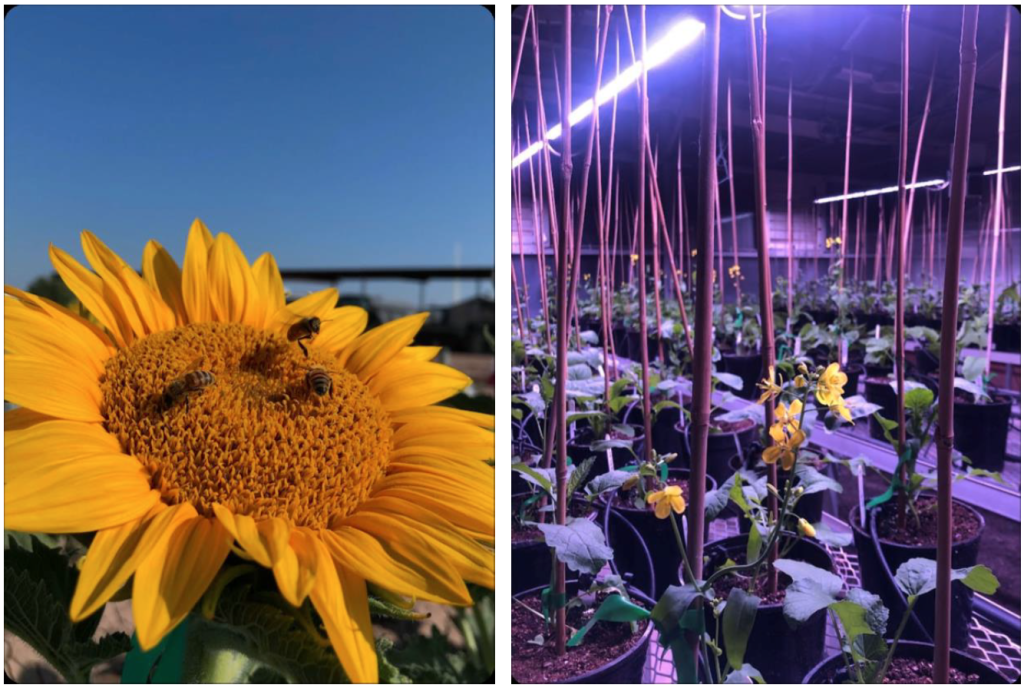
Figure 1. Honey bees visiting sunflowers in the field to test the attractiveness of different cultivars. The nutritional composition of the pollen from the sunflowers also was collected so comparisons could be made among the cultivars. Brassica plants also are grown in greenhouses under controlled conditions to determine the effects of environment on nutrients in pollen.
The last area of research in the VC-H lab focuses on how the environment might affect the nutritional value of bee forage (Figure 1). This area of investigation was prompted by discussions with stakeholders and scientists, and visits to the Northern Great Plains in an atypically dry year. Using sunflowers, an abundant Summer/Fall resource in the Upper Midwest, VC-H and colleagues from the Fargo, North Dakota ARS lab first looked at how pollen nutrients differed for plants grown in either North Dakota or Arizona at the same time of year. Essential nutrients, such as fatty acids differed across locations, suggesting that plant growth conditions affect pollen nutrition. The team is now using field, greenhouse and growth chamber experiments to test this question under more controlled conditions where temperature and soil moisture can be carefully manipulated. This project has multiple implications for honey bee nutrition and colony health. For example, if drought diminishes pollen nutrients, and certain plant cultivars are more resistant to drought, bee health might be improved by growing these cultivars in drought-prone areas. Knowing how environment affects bee nutrition can also translate to better predictions for how colony health will respond to different weather conditions.
Dr. Mark J. Carroll (MJC)
The MJC lab examines how honey bee stressors (poor nutrition, pesticides, parasites and pathogens) affect coordination and performance of critical colony functions such as queen care, brood rearing, nutritional balance and resistance to pathogens and parasites. The MJC lab also has led the efforts to analyze the nutritional composition of pollen by developing nutrient analysis methods for amino and fatty acids. The development of the nutritional analysis methods has enabled our investigations of the nutrient composition of seasonal pollens, and effects of environmental and genetic factors on the nutrients in pollen.
In addition to developing methods for nutritional analyses, MJC also researches semiochemical (pheromones, odors, other chemical cues) communication systems in the hive. As a chemical ecologist, MJC identifies the chemical cues that trigger worker behaviors for important colony tasks including queen care, brood and adult feeding, food stores maintenance and hygienic responses to disease and parasites. However, semiochemical-mediated communication can be disrupted by colony stressors. Our research is directed at understanding how semiochemical communication is affected by stressful conditions, and then use this knowledge to counter stressors through better monitoring, management interventions, and targeted development of hive remedies. The MJC laboratory recently identified odor cues that strongly attract nest workers to starving adults and brood, the first step in feeding support of malnourished individuals. Some of these are colony pheromones that vary considerably with individual and colony nutritional states and affect worker nursing behaviors. MJC is currently examining how workers respond to starvation cues during times of forage dearth and abundance. The odors may provide insights into the colony nutritional state and could serve as tools to determine if supplemental feed and management approaches are reducing malnutrition.
The Carroll lab is exploring how chemical signaling might be used to improve hygienic behavior. Pathogen-infected and parasite-infested bees give off odors that differ from healthy individuals, whether as generalized distress signals, odors from damaged tissues or odors produced by the natural enemies themselves. Workers use chemical cues to detect and hygienically remove stressed individuals from the colony before they become highly infectious to other colony members. MJC is exploring chemical signals associated with early infections that may serve as cues for rapid hygienic responses. To date, MJC has identified odor cues produced by asymptomatic larvae and adult workers during the early stages of infection by the chalkbrood pathogen Ascosphaera apis. Similar cues produced by bees infected by other pathogens and parasites could be used to select for hygienic lines with more timely and targeted responses.
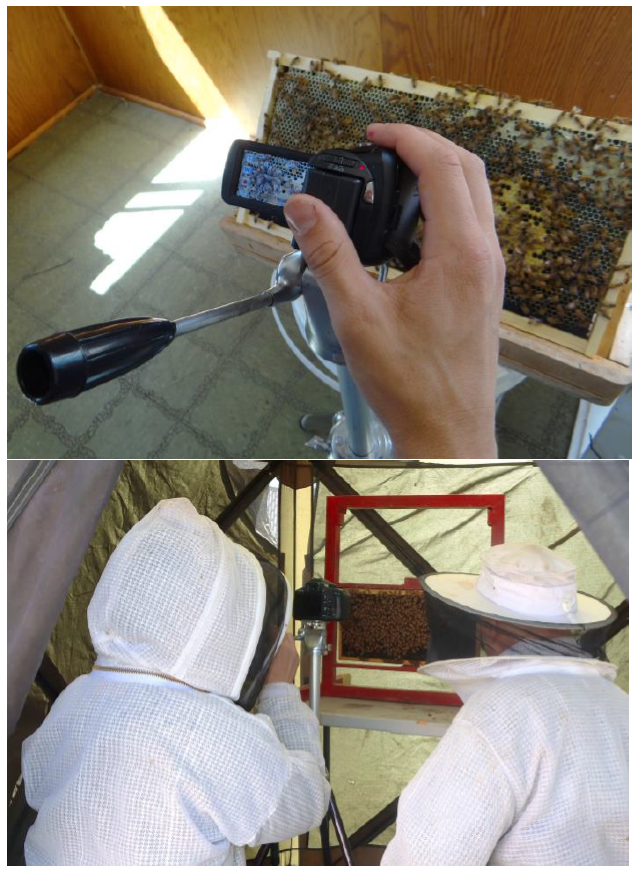
Figure 2. The Carroll lab observes queen retinue behaviors in temperature-controlled conditions. Please note that daylight has been added to see activities here. These videos are usually taken under red light or in shaded tents.
A central focus of the Carroll Lab has been on improving queen quality and productivity. Queens are largely shielded from direct impacts of colony stressors such as poor nutrition and pesticide exposure by the workers that tend them. However, stress can affect the queen indirectly through the workers that care for her and raise her brood. MJC recently found that worker hypopharyngeal glands and internal nutrient stores (used to make jellies to feed queens and brood) decrease sharply as the colony expands after crop pollination probably due to increasing nutritional stress. Improving worker seasonal nutrition supports both queen productivity and brood rearing as colonies endure nutritional dearths (Figure 2). Exposure to pesticides might also affect queen health. MJC recently found that the Insect Growth Regulator, methoxyfenozide does not affect queen development, most likely due to the absence of the compound in royal jelly but does affect queen mating and sperm storage.
Dr. William Meikle (WM)
The Meikle lab focuses on continuously monitoring the activities of bees within the hive or laboratory cages to determine how factors such as pesticides, cold storage or queen line influence colony weight (i.e., growth, foraging activity and honey stores), internal temperature and CO2 concentration. Once installed, the electronic sensors can detect changes in honey bee behavior and colony population dynamics with little or no colony disturbance and provide objective longitudinal data. Methods have been developed to statistically model daily weight changes. Those changes provide information about colony food stores and dramatic shifts in adult bee population associated with events like swarming, bee kills or robbing. Within-day changes in weight reveal foraging activity, foraging success and the precise activity schedule of the hive.
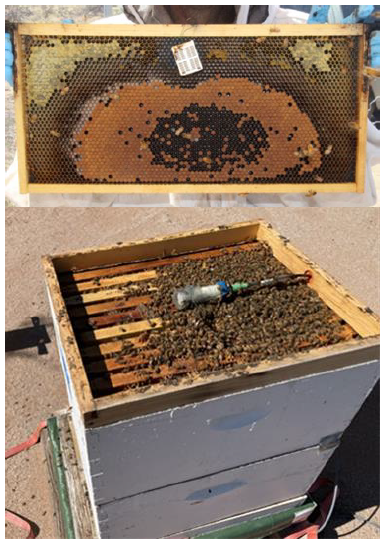
Figure 3. Temperature sensor installed near the top rail of the center frame in a hive. The CO2 sensors are installed in a riser space on top of the frames.
Colony temperature, humidity and CO2 also can be continuously monitored. The values obtained depend on where in the hive the sensors are placed (Figure 3). For example, temperature sensors installed in the brood area to monitor thermoregulation provide different values than sensors placed outside of the cluster near the interior wall of the hive. Average brood nest temperature and variability provide a strong signal regarding colony survival and success. In addition, temperature variability is highly correlated with brood rearing effort and can be used to identify factors that disrupt this activity. Our data on CO2 levels in the hive indicate that concentrations can be much higher (over 100 times) than ambient levels and much more variable. CO2 concentrations above ambient concentrations are generated by the bees, so CO2 concentration data has information on the behavior and health of the colony.
WM’s lab has used continuous monitoring methods to explore the effects of sublethal pesticide exposure on bee colony behavior. For example, experiments conducted over five years with imidacloprid, a neonicotinoid pesticide, showed that thermoregulation, hive CO2 management and daily hive weight change were significantly affected by pesticide exposure and can impact colony growth and activity even at very low concentrations. The research showed that imidacloprid could inhibit certain colony behaviors at high concentrations (100 parts per billion), and agitate the bees at low concentrations (five parts per billion). Thermoregulatory behavior also was monitored using sensors in a temperature-controlled laboratory incubator with cages containing small groups of bees exposed to different levels of pesticides and daily temperature cycles. We found that even among small groups of bees without a queen or brood, the pesticide affected clustering behavior and thermoregulation. Continuous monitoring data also revealed effects on colony-level behaviors after exposure to clothianidin (another neonicotinoid) and methoxyfenozide (an insect growth hormone mimic).
Colony behavior, particularly thermoregulation, also has been monitored in commercial settings. In a recent study, WM’s group monitored the colony size and temperature of hives placed in different kinds of environments, from agricultural areas like California’s Imperial Valley, to unmanaged areas. Pesticide residues also were monitored, and results showed that while pesticide exposure, both in terms of concentration and diversity, varied among the environments, it was not often a major determinant of the health of commercial colonies. The factor most affecting colony health was access to forage. Studies conducted by WM’s group monitored the effects of hive orientation on colony growth and behavior and found that east and south facing hives had significantly more foraging activity than others in the Spring. Screen bottom boards also were found to affect thermoregulation and hive CO2 levels. Colonies increased CO2 concentrations when the hive was better ventilated with a screen bottom board, indicating that maintaining high CO2 concentrations for at least part of the day is important for bee colonies.
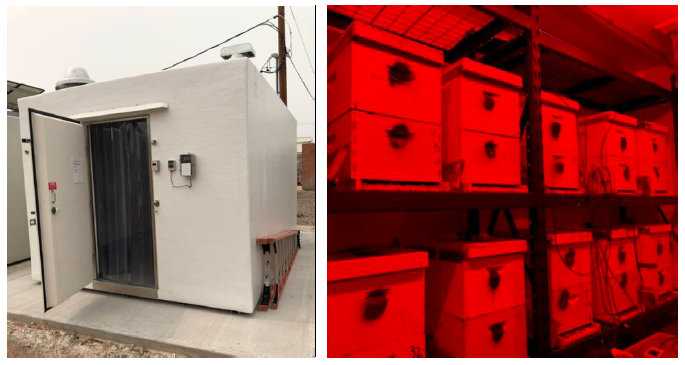
Figure 4. The honey bee cold storage unit (HBCSU), with adjustable ventilation fans, CO2 sensors and temperature control. Hives inside the cold storage unit. The hives were fitted with individual CO2 sensors.
In 2020, the CHBRC installed a cold storage unit (CSU), with temperature and CO2 monitoring and controlled ventilation to explore the effects of cold storage on the health of the colony and on individual bees (purchase of unit partially funded by Project Apis m.) (Figure 4). Currently, the WM lab has been monitoring weight, temperature and CO2 levels in hives stored in the CSU for short periods to induce Fall brood breaks or for longer periods for hive overwintering. The CSU is ideal for the studying of circadian rhythms and the role of CO2 concentration within the hive. In current experiments, hives in the cold storage unit experience constant temperature (about 5°C) and no light, so there are no external cues to “set” any circadian rhythms. Colonies are equipped with temperature and CO2 sensors that generate data that reflect locomotor activity, which is typically used in circadian studies. Within-hive temperature and CO2 control are “emergent” behaviors coming from colonial living, so these studies may reveal new aspects of bee colony behavior and ecology.
Dr. Kirk E. Anderson (KEA)
Studies on the role that microorganisms play in the processing of nectar and pollen in individual bees and the colony are essential to fully understand honey bee nutrition. KEA has characterized many fundamental processes associated with the gut microbiome (i.e., the collection of microorganisms established in the digestive system) and social microbiome (microorganisms transmitted among bees), producing a comprehensive understanding of microbial ecology in the honey bee gut and colony. The specialized bacteria that populate the adult worker hindgut govern or contribute to a variety of physiological processes and behaviors. The bacteria are critical for colony health and have been defined and characterized according to the symbiotic and highly beneficial functional relationships they provide to the bees.
A focal project in the KEA lab is the microbes associated with social nutrient processing. This includes food stores and developing larvae. The adult honey bee gut, larvae and food stores have a highly predictable but very different social microbiome that prospers with exposure to oxygen. This set of oxygen tolerant microbes is found throughout the colony environment. Like aerobic environments in humans (e.g., skin, lungs, mucus membranes), the social microbiome functions in general social hygiene, controlling the growth of Nosema in the midgut, and other pathogenic fungi and opportunistic microbes common throughout the hive environment.
While many microbes are routinely introduced from the pollination environment, the social microbiome is comprised of a suite of beneficial bacteria and yeasts that is part of the microbial collection carried with worker bees when they swarm. Two primary species of bacteria that dominate the social microbiome, Lactobacillus kunkeei and Bombella apis, are core species that also colonize and reside in the queen gut. Newly emerged queen bees do not contact their mother queen, so they might acquire their gut microbiota through contact with the hive and social environment. The microbes carried by a swarm include those that populate the queen gut and the hive environment. When filled with stored food and developing young, the hive environment provides a variety of niche characteristics similar to those encountered in the hindgut environment. KEA has recently shown that the social microbiome is enhanced with exposure to propolis (plant resin) nearly tripling in size relative to low propolis colonies. Additionally, colonies lined with propolis resulted in a 10x reduction of fungi in the hindgut, and significantly more robust bacterial microbiomes.
Symbiotic relationships between the insect Order Hymenoptera and fungi are numerous, and the relationship between bacteria and fungi in the gut is an emerging area of study. The worker midgut possesses the largest fungal microbiome and is affected by changes in pH and oxygen. Studies by KEA suggests that the midgut of late Winter bees is vulnerable to invading microbes following an age associated transition in physiology, and if not countered by immune responses, may contribute to an imbalance among beneficial microorganisms (i.e., dysbiosis) and premature senescence of workers and colonies. In a study with colonies overwintered in cold storage, all sampled worker bees effectively transitioned to long-lived Winter bees. In contrast, colonies kept outdoors in mild Winter environments did not develop into long-lived Winter bees and the aging workers suffered dysbiosis that proliferated primarily in the midgut. Fungal load increased significantly in the midgut and hindgut overwinter, concurrent with significant increases of bacterial opportunists in the midgut. The hindgut microbiota remained relatively unchanged indicating that the midgut is a target tissue for host health in aging foragers and overwintering workers.
In addition to studying the microbes in the worker honey bee gut, KEA has also examined the microbiome of queens. Early queen death or rejection by the colony has become more common in beekeeping. KEA placed newly mated commercially produced queens in either small containment cages (i.e., queen bank) or free-running and laying eggs in colonies. Feeding intensity, social context, and metabolic demand differ greatly between the two environments. A microbiome analysis examining the queen’s mouthparts, midguts, ileums and rectums, and associated gene expression analysis of other tissues found that both social context and queen breeder source affect gut microbiota and associated queen metabolism. For example, free-running queens exposed to the colony environment contained significantly less bacterial diversity than the banked queens indicating that social immune factors may shape the queen’s microbiome. Queens housed in queen banks resembled much older queens with decreased beneficial bacteria in the hindgut, and significantly larger ileum microbiotas, dominated by blooms of worker associated gut bacteria. Combined with earlier findings, it is evident that the queen gut microbiota experiences an extended period of microbial succession associated with queen breeder source, post-mating development and colony assimilation. The results suggest that queens may produce signals based on the microbiome that are perceived by workers. In collaboration with commercial beekeepers, we are testing these hypotheses in the coming year.

Figure 5. Feeding supplements to commercial colonies to test for effects on gut microbiota and colony health.
Microbes that do not originate from the honey bee gut or hive environment stand little chance of establishing and surviving in a honey bee colony. KEA performed a longitudinal study of commercial honey bee colonies to explore the effects of probiotics both over the long term, and following antibiotic treatment. The two tested probiotics were comprised of various lactic acid bacteria and yeast commonly fed to humans or used in large animal agriculture. The probiotics had no effect on colony growth, colony weight, the gut microbiome or disease status following seven months of probiotic treatment applied as suggested, or when applied to aid recovery from antibiotic induced dysbiosis. The study concludes that non-native probiotics cannot survive in the honey-rich hive environment or highly competitive worker gut environment (Figure 5).
Dr. Gloria DeGrandi-Hoffman (GD-H)
GD-H’s research program investigates colony population dynamics and the effects of Varroa, nutrition, and most recently climate change on colony growth and survival. The studies on climate change and Varroa led to research to develop best management strategies for overwintering colonies in cold storage. GD-H has studied the population dynamics of honey bee colonies and built computer models to predict factors that influence the growth and survival of colonies throughout the year. Her studies on honey bee nutrition are predicated on colonies having a yearly life cycle, that might cause nutritional requirements to differ between times of brood rearing and colony expansion in the Spring and population contraction and preparation for overwintering in the Fall. Collaborating with Mark Carroll and Vanessa Corby-Harris, polyfloral mixes of Spring and Fall pollens were analyzed to determine if the nutrient composition differed with season. Next, seasonal pollens were fed to bees reared in Spring and Fall, and comparisons were made of the effects on brood food gland development (i.e., hypopharyngeal glands – HPG), and the expression of genes in the fat body between bees fed pollen from the same (in-season) or different season (out-of-season) from when they were reared. Because pathogen challenges often heighten the effects of nutritional stress, GD-H infected a subset of bees with Nosema to determine if bees responded differently to the infection depending on the seasonal pollen they consumed. She found that Spring and Fall pollens were similar in total protein and lipid concentrations, but Spring pollens had higher concentrations of certain amino and fatty acids that support hypopharyngeal gland (HPG) growth and brood production. Bees responded differently when fed in vs. out of season pollen. The HPG of both uninfected and Nosema-infected Spring bees were larger when they were fed Spring (in-season) compared to Fall pollen. Pollen type also affected gene expression and physiology in Spring bees. Fall bee responses to pollen type and Nosema infection differed from Spring bees. In Fall bees, HPG size was not affected by pollen type, though HPG were smaller in bees infected with Nosema. The study showed that physiological responses to seasonal pollens differ between bees reared in the Spring and Fall with Spring bees being significantly more sensitive to pollen type especially when infected with Nosema. The study provided evidence that seasonal pollens may provide levels of nutrients that align with the activities of honey bees during their yearly colony cycle. The findings are important for the planning and establishment of forage plantings to sustain honey bees, and in the development of seasonal nutritional supplements fed to colonies when pollen is unavailable.
A major factor influencing colony survival is Varroa mites. Using Varroa and colony population dynamics models she created with Robert Curry, GD-H found that the growth of Varroa population in colonies far exceeds what is predicted by Varroa reproduction alone. This led to research on the migration of Varroa into colonies on foragers as a possible explanation for the rapid mite population growth in colonies, especially in the Fall. She found that the frequency of capturing foragers with mites at colony entrances was correlated with Varroa population growth. This occurred with mite resistant Russian bees and unselected lines of bees. Research in collaboration with Dr. Judy Chen from the ARS Beltsville Bee Lab showed that Deformed Wing Virus (DWV) levels increased throughout the Summer and Fall and were correlated with the increasing Varroa infestation levels. She tested if supplemental feeding could reduce DWV levels but found that both Varroa and DWV levels were similar between colonies with and without supplemental pollen feeding.
Reducing overwinter colony losses using cold storage has been the most recent area of study for the GD-H lab. This area of research was pursued because climate change is affecting many aspects of beekeeping and colony survival including overwintering survival. Warm temperatures in Fall and even during periods in the Winter in temperate areas cause honey bees to fly when they should be clustered in the hive. Warmer Fall temperatures can lead to extended periods of foraging late in the season resulting in greater proportions of physiologically older bees in the Winter cluster and a deeper population decline during Spring dwindling. Placing hives in cold storage would curtail Fall foraging and possibly preserve the longevity of Winter bees. Cold storage could also reduce Fall miticide applications needed to suppress Varroa population growth from mite migration.
Our research on cold storage began with an analysis of costs for overwintering colonies followed by studies to determine which colonies should be put into overwintering facilities. The cost analysis revealed that putting colonies in cold storage costs less per colony than overwintering them outdoors in southern locations. However, the study also revealed that not all colonies are suitable for overwintering in cold storage. Colonies do not increase in population in cold storage. In fact, colonies lose three to five frames of bees on average. Also, colonies with Varroa do not do well in cold storage. Our study showed that colonies to be managed for cold storage overwintering should be selected in September based on their size and mite loads. To assist beekeepers in choosing colonies to put into cold storage, we developed a decision support tool (https://www.ars.usda.gov/pacific-west-area/tucson-az/carl-hayden-bee-research-center/research/cold-storage/cold-storage-overwintering-tool/) that predicts the probability of a colony achieving a particular size after cold storage based on its size and mite numbers (mites per 100 bees) in September.
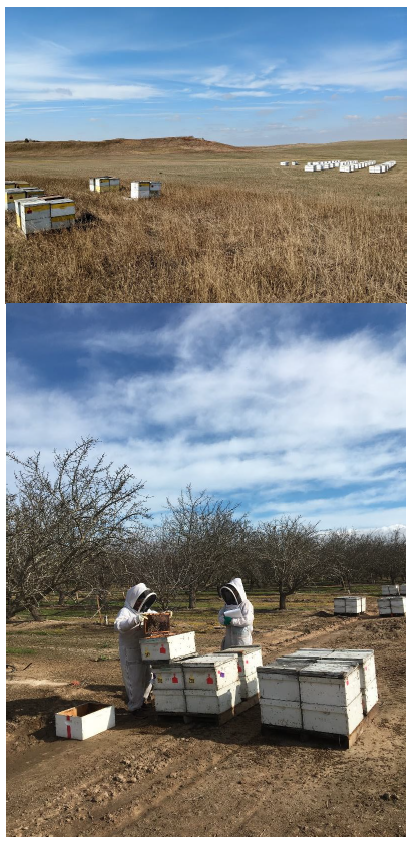
Figure 6. Colonies in North Dakota that were put in cold storage for overwintering. The colonies measured for strength in almond orchards after overwintering in cold storage.
The next questions addressed by GD-H research is when to put colonies in cold storage. Through a study of colonies that spent the Summer in North Dakota, we found that putting colonies in cold storage when they contain only sealed brood and adult bees results in colonies with larger populations and more brood immediately after cold storage compared with those put in cold storage later when they contain only adult bees (Figure 6, next page). The colonies put into cold storage that contained bees and sealed brood also were larger after almond pollination. We also tested if colonies from southern regions that are still rearing brood can be successfully overwintered in cold storage. We found that colonies that spent the Summer in Texas apiaries and then were put into cold storage in November were significantly smaller after cold storage and after almond pollination than those that summered in North Dakota. Our current research is investigating the role that queen line might play in successful cold storage overwintering and is being done in collaboration with Drs. Lanie Bilodeau and Kate Iles at the ARS Baton Rouge Bee Lab. Stay tuned for results.
Grand Challenge Synergies Project
The CHBRC is leading a Grand Challenge Synergies project to create pollinator landscapes and overwintering practices to increase pollinator populations in a changing climate. Grand Challenge projects are designed to address high-order problems of national importance by integrating multiple existing projects across National Programs, Agencies, Universities and the private sector and building collaborations to create something more than the sum of their parts. Our project includes 10 CRIS projects, four National programs, three USDA agencies, four Universities and four private businesses.
Climate change is impacting the survival and diversity of pollinators in two fundamental areas: availability of flowering plants that supply food to pollinators during periods of nest establishment, expansion and reproduction, and survival during overwintering. Our project addresses both challenges by creating a coordinated interdisciplinary effort that incorporates the interactions of genetics (both pollinators and plants), environment, management practices and end users that will play critical roles in developing and implementing the innovative strategies generated from our Project. Specifically, we will assess the composition and nutritional value of landscapes planted to sustain pollinators, determine the effects of genetic, environmental and management factors on the nutrient composition of floral rewards such as pollen, and determine the impact on pollinator diversity and health. We will link nutrition, genetic and environmental factors with management practices to address the second fundamental area being affected by climate change; overwintering survival. By including studies to improve floral landscapes for nest establishment and expansion and management practices to increase overwintering survival, we present a comprehensive year-round plan to sustain and grow pollinator populations. Our findings will be shared with stakeholders involved in production of crops requiring bee pollination, land managers, beekeepers and companies and organizations providing seeds for pollinator plantings so that strategies to ensure pollinator diversity and population growth will be feasible and sustainable in a changing climate.




